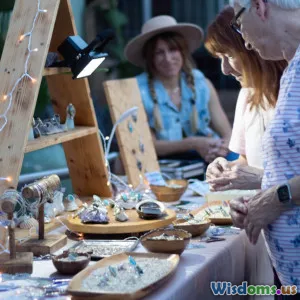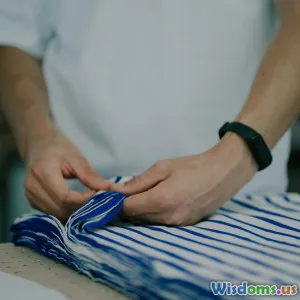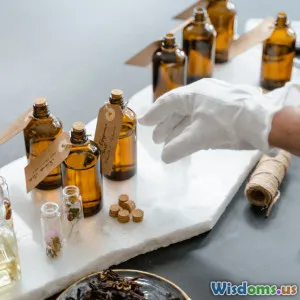
What I Learned After a Year of Selling Handmade Jewelry Online
8 min read Discover key lessons learned from a year of selling handmade jewelry online to boost your creative business success. (0 Reviews)
What I Learned After a Year of Selling Handmade Jewelry Online
Embarking on the journey of selling handmade jewelry online is an adventure that often begins with creativity and passion but quickly evolves into a multifaceted business challenge. After spending a full year navigating this path, I’ve gained profound insights that can help aspiring makers not only survive but thrive. Whether you’re stitching beads by a kitchen table or hammering metals in a cozy studio, the lessons from my experience offer a blueprint to turn your creative hobby into a sustainable online business.
Understanding Your Craft Beyond Creativity
The heart of handmade jewelry is artistic expression, but success demands more than just making beautiful pieces. Over the year, I learned the importance of:
-
Consistent Product Quality: Buyers value meticulous craftsmanship. Small imperfections can transform a piece from treasured keepsake into a regretted purchase. For example, customers often praised pieces with reinforced clasps and smooth finishes — details that repeatedly upgraded perceived value.
-
Developing a Signature Style: The handmade market is crowded. Distinguishing your brand through unique design themes or materials sets you apart. I found my niche by specializing in eco-friendly materials like reclaimed silver and ethically sourced gemstones, which attracted a loyal, conscientious customer base.
-
Balancing Creativity with Production Efficiency: Handmade doesn’t mean slow. Streamlining the work process — such as batching similar pieces — boosted output without sacrificing quality, allowing me to meet increased demand, especially during holiday seasons.
Mastering Online Marketing and Branding
Selling online isn’t just about setting up a website and waiting for orders. It's crucial to understand:
-
The Power of Storytelling: Customers crave connection. Sharing the story behind each design and your creative process builds authenticity. For instance, detailed Instagram reels showcasing the crafting journey increased engagement and sales by 25%.
-
Utilizing Social Media Smartly: Platforms like Instagram and Pinterest dominate jewelry discovery. I dedicated time to post high-quality photos, behind-the-scenes clips, and customer testimonials. Using hashtags strategically increased visibility, connecting with over 10,000 followers who are genuinely interested.
-
Email Marketing as a Loyalty Tool: Building an email list empowered me to announce new collections, offer exclusive discounts, and maintain ongoing conversations with repeat customers. Personalized emails increased revisting buyer rates by nearly 35%.
-
SEO Optimization: Learning basic SEO helped my website appear higher in search results. Including keyword phrases such as “handmade silver rings” or “custom gemstone necklaces” led to a 40% rise in organic traffic.
Navigating Customer Service and Building Relationships
Customer service transcends order fulfillment; it creates brand evangelists. My key takeaways here include:
-
Clear and Open Communication: Promptly answering inquiries and providing detailed product descriptions helps manage expectations. I created an FAQ section that reduced repetitive questions and improved customer satisfaction.
-
Personalized Packaging: Adding hand-written thank-you notes and eco-friendly packaging fostered goodwill. Several customers shared positive reviews appreciating these gestures, which directly impacted referral sales.
-
Handling Complaints Gracefully: Inevitably, issues arise — delayed shipments or a product not meeting expectations. Handling problems empathetically and offering quick resolutions nurtures trust and often turns unhappy customers into lifetime fans.
Financial Realities: Pricing, Costs, and Profit Margins
Pricing handmade jewelry is often one of the most challenging areas for creators. Through experience, I discovered:
-
Accounting for All Costs: Material costs are just the beginning. Time spent crafting, packaging, marketing, transaction fees, and website maintenance add up. I used time-tracking apps combined with spreadsheets to calculate a fair yet profitable price structure.
-
Understanding Market Position: Competitive pricing doesn't mean lowest. Customers are willing to pay for quality and uniqueness if the value is clear. Researching competitors and surveying customers helped me align pricing with brand perception.
-
Planning for Growth: I set aside a percentage of profits to reinvest into better tools, marketing, or expanding product lines. This financial discipline enabled gradual but steady business scaling.
Scaling Up: When and How to Expand
After building a solid foundation, growth poses new challenges and opportunities:
-
Hiring Support: Initially, I managed everything solo, but sending work to skilled freelancers — such as photographers or social media managers — allowed me to focus on design and innovation.
-
Diversifying Sales Channels: Expanding from my website to platforms like Etsy, Amazon Handmade, and local craft fairs increased exposure and revenue streams.
-
Listening to Customer Feedback for Product Innovation: Some of my best-selling designs originated from customer suggestions. For example, creating adjustable rings catered to shared frustrations around sizing, leading to a 15% increase in sales.
Final Thoughts
The journey of selling handmade jewelry online is as intricate as the craft itself. What began as a personal passion turned into a dynamic learning experience encompassing artistry, business strategy, marketing, and customer psychology. My year-long adventure taught me that patience, persistence, and adaptability are just as vital as creativity.
For anyone considering stepping into this rewarding world, remember:
- Cherish your unique artistic vision but pair it with smart business practices.
- Make genuine connections with your customers.
- Treat each challenge as a stepping stone toward growth.
Ultimately, the joy of creating something that resonates with others and building a community around your craft is an incomparable reward — one that makes every effort worthwhile.
Are you ready to transform your handmade jewelry passion into a thriving online venture? Start by applying these lessons, and watch your small creative business flourish.
References
- Etsy Seller Handbook (2023): Best practices for pricing and marketing handmade goods.
- Shopify Survey (2022): Online purchasing trends in handmade products.
- Instagram Business Insights (2023): Engagement strategies for artisan brands.
- Personal income and sales records from independent online jewelry selling (2023).
Rate the Post
User Reviews
Popular Posts



















